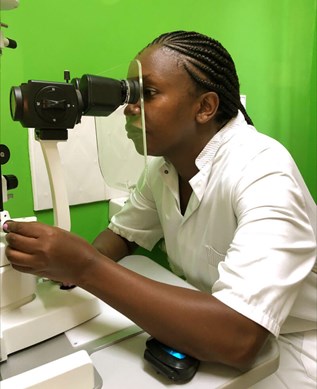
Eye News spoke to Dr Monicah Bitok, Global Inclusive Eye Health Advisor with the Christian Blind Mission (CBM), about the rise in diabetes-related preventable blindness, systemic ophthalmic changes in low- and middle-income countries, and the impacts of a COVID-19-induced backlog on ophthalmic services.

The COVID-19 pandemic has led to challenges accessing eye services. How far has this combined with a lack of diabetes treatment, creating an even greater problem?
The coronavirus pandemic has had alarming impact on eye care. In the initial phase of the pandemic, some eye health units closed except for emergencies. The patient numbers attending the eye clinics also reduced due to fear of contracting the disease. The restriction measures, such as restriction of movement, also meant patients could not access eye care services. Outreach activities to identify patients in rural areas were stopped; patients had to pay for COVID tests before treatment, but poorer people cannot afford this, nor the cost of the journey to hospital. Many people lost their incomes, and so can’t afford to access eye treatment. Finally, patients with chronic eye conditions like diabetic retinopathy, glaucoma and other causes of irreversible blindness could not access eye care services and medication; as a result, some patients are irreversibly blind.
Equipment and training are the keys to preventing avoidable blindness – is education the key to preventing avoidable blindness from diabetes in lower income countries?
An inadequately skilled workforce is a major hinderance in accessing quality eye care services in the countries we work in. The distribution of the available people is also skewed, with the large urban centers having a larger workforce, and the rural populations, which have the highest prevalence of eye diseases, having the smallest workforce. The costs of travel therefore make eye care services inaccessible to the poor.
The general health care workers don’t have adequate knowledge on diabetic eye disease, and therefore diabetes patients presenting at the hospital for diabetic care miss screening opportunities and timely referrals to the eye clinics.
It is imperative to train more workers in order to offer diabetic retinopathy screening and treatment services. It is also important to sensitise all general health workers on the importance of screening all diabetic patients for diabetic eye disease.
There is also a need to educate the public on diabetic complications, so that they take charge of their health and seek screening services and treatment early.
Most facilities are also not well equipped. It is crucial that as we train the workforce, alongside adequately equipping the hospitals.
CBM Global target both equipment and human resource training, but the demand is huge and requires a lot funding.
Are there plans to involve specialists to treat diabetes-related vision loss? Are CBM hoping to specialise across the causes of vision loss, or is the situation so critical that general aid is the priority?
Diabetic retinopathy is one of the leading causes of irreversible vision loss, and its impact is felt more in the productive age group. The prevalence is also higher in developing countries, and is expected to keep rising with changes in lifestyle, population growth and increasing life expectancy. Apart from cataract, diabetic retinopathy is one of the priority eye diseases for CBM Global. Other priority eye diseases include glaucoma, NTDs, retinopathy of prematurity, and refractive errors.
CBM Global works with available specialists in the different countries to manage these conditions; where specialists are not available, we support their training.
Will we ever see an end to the COVID-19-induced backlog for eye treatment?
As service provision returns to normal, CBM Global is putting in effort to try and clear the backlog as well as the new cases. This is being done through strengthening primary eye care services, through outreaches and strengthening the capacity of the hospitals to offer more services. However, this requires a lot of resources and collaboration, with all stakeholders involved in eye care service provision.
After the latest financial push and incoming of aid, what are the systemic changes that will benefit from them? Is the aim to focus on preventative measures rather than reactive ones?
There is a great need to increase investment in primary eye care, eye health promotion and prevention. Most eye conditions that cause preventable blindness can be picked up earlier through primary eye care programs, as opposed to waiting for them to present to the hospital, often when the condition is advanced and with poor treatment outcomes.
Some minor eye conditions can be handled at the lower levels of the health system, and this reduces the strain on the few eye health facilities.
To ensure a wide coverage when educating/sensitising/disseminating eye health information, CBM Global works with community health workers, community health volunteers, community leaders and primary eye care workers at the dispensaries and health centres. We also use local media stations to educate the public.
As we strengthen primary eye care services and increase demand of services at higher-level facilities, we must also strengthen the provision of quality eye care services at the hospitals, we must strengthen rehabilitation services for those who have irreversible vision loss or low vision, and we must ensure children with low vision are able to access education, and for the adults to participate meaningfully in the society.
We aim at ensuring our projects are integrated and people-centered by targeting health promotion, prevention, curative and rehabilitative services while working with different levels of the health system. Discussions are ongoing on strengthening integration and implementing more comprehensive projects. For instance, diabetic care would require a multidisciplinary approach involving the physicians, nutritionist, counsellor, renal specialist, eye care and so on.
Eye News would like to thank Monicah for her time.
To read more about CBM Global, and to donate as part of their
Light up Lives initiative, visit: www.lightuplives.net
COMMENTS ARE WELCOME





